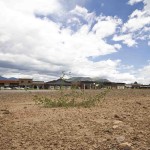 At the September 14 Flagstaff City Council meeting, the Council will put the finishing touches on the plan chosen to sell the south half of the Aspen Place at the Sawmill project, which fell into default and into the hands of the city in June.
At the September 14 Flagstaff City Council meeting, the Council will put the finishing touches on the plan chosen to sell the south half of the Aspen Place at the Sawmill project, which fell into default and into the hands of the city in June.
The Aspen Group, the original developer, has found a buyer for the north half of the project. They hope the deal will close with Red Development at the end of September, says Jim Cronk, planning director for the city.
The businesses that have already located there are content.
“They are doing fabulous and loving it there,” Cronk said.
The southern half of the project is still at issue. The Aspen Group was unable to make the payments to repay the bonds sold to pay for infrastructure like water, sewer pipes and roadways. “It was deeded to the city. We own the southern half,” Cronk said. “Now we are in the process of disposing of the residential part of the property.”
He said the mix of housing in the original development plan would probably remain the same.
Aspen Place at the Sawmill was planned as a mixed-use development located southwest of Butler Avenue and Sawmill Road and east of Lone Tree Road. It was to be built on 40 acres and contain 155,000 square feet of retail and restaurant units and 255 residential units. There were to be 51 single-family homes, 64 townhomes, 122 condos, 14 lofts and four live/work units, ranging in price from $400,000 to $900,000. It was supposed to target an upscale resident, offer a pedestrian-friendly community near downtown Flagstaff and offer retail businesses, entertainment and dining. Named in honor of the Stone Forest
Sawmill that once sat there, it was intended to transform Flagstaff’s industrial downtown corridor into a beautiful, lush urban lifestyle in the mountains. The jewel in its crown was to be Flagstaff Paseo, which would be a gather- ing place featuring an outdoor amphitheater and patio dining. It could also be used for city-sponsored events like concerts and holiday celebrations.
Of course, that was all before the downturn in the economy left the developer and the city in the lurch for work already completed that was paid for by bonds that the developer is unable to pay.
Possibilities looked bright in February 2007 when a financial feasibility study was conducted by the ESI Corp. for the city of Flagstaff. The study considered what the income might be if the city entered into a 20-year contract with the Aspen Group. Under the agreement, the city would provide a sales tax rebate to the developer for 20 years. During that time, Aspen Place was estimated to generate $36.2 million in taxes and fees to the city, including the tax revenue from the shops and restaurants at $24.4 million, property taxes at $8 million and the sales tax during the construction of the project estimated at $1.5 million.
Portions of the development’s streets, sewers and water were financed by bonds the developer would pay back over 20 years from the profits of the projects.
The total bond for the original development was about $20 million. If the deal with Red Development closes as planned, the city will then own about $9.5 million of the debt.
The next bond payment of $600,000 is due in December and the next in June.
“We are trying to find a fair way to put it to- gether and let the private sector do what they do best – and we know that,” Cronk said.
Hopefully the units will sell quickly and development can begin. FbN







